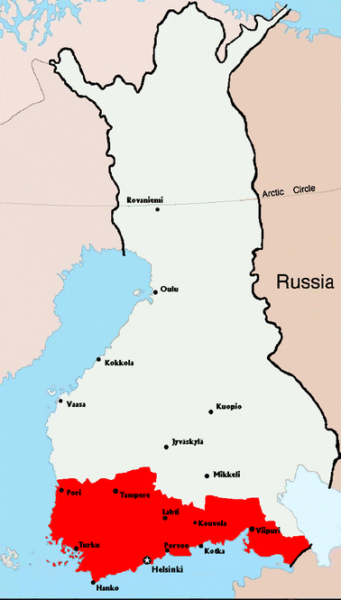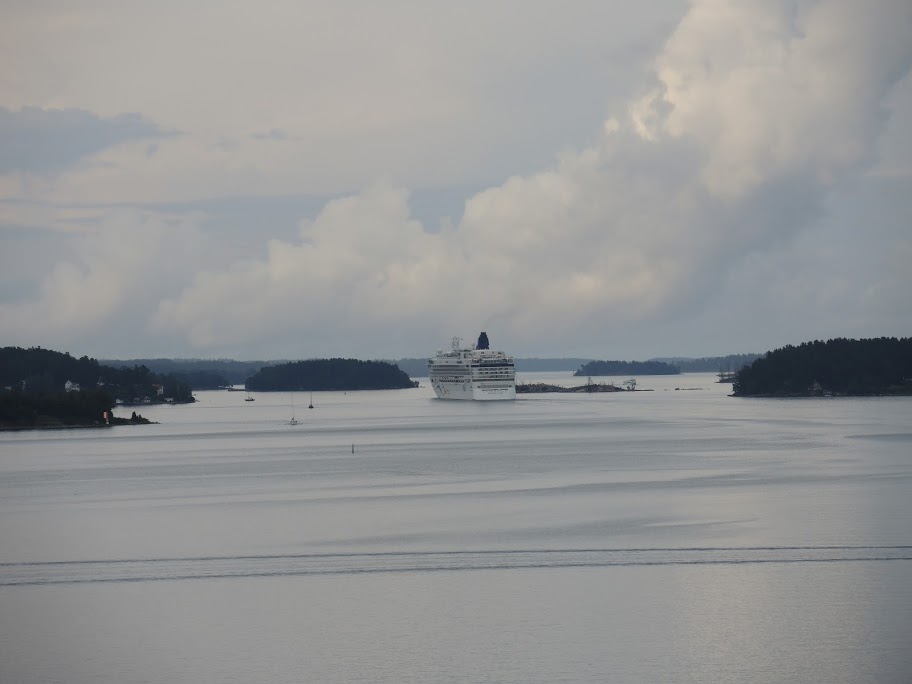It’s late Thursday afternoon on my eighteenth day away from home and here’s my remaining itinerary:
Tonight: Ride the ferry overnight across the Baltic Sea from Stockholm to Helsinki;
Friday morning: Arrive in Helsinki; Three hour guided bus tour;
Friday afternoon: Two to four hours wandering Helsinki on my own;
Friday night: Return on the ferry overnight to Stockholm beginning 36 hours of continuous travel.
Saturday morning and onward: Get off the ferry and into a taxi to Arlanda Airport; Check in for the flight to Frankfort; Change planes to the flight to Dulles; Get the Super Shuttle home.
I’ll start with this. I have to assume that the ship that transported us from Stockholm to Helsinki is called a ferry because it’s built to accommodate buses, cars, and other road transport vehicles. But a look at its exterior,
or its interior,
is more evocative of a cruise ship than a ferry. Reinforcing that notion, this ship can carry up to 2,800 passengers in some 900 or so cabins and it has a casino, at least eight restaurants, other lounges and bars, live performances on both the promenade and in a theater, a special kids’ zone, and lots of places to shop on board.
Even without all that shipboard extravagance, this would be an impressive cruise to take. The distance between Stockholm and Helsinki is about 400 kilometers and for the first 50 kilometers or so as you depart Stockholm you sail through the Stockholm Archipelago. Perhaps had it not been quite so rainy, windy, and chilly, I would have been able to snap a few more photos to give you a better idea of this experience but here’s one shot that I hope manages to capture it in some fashion.
And, here are a few others that manage to do so probably even less effectively.
While we’re at sea, let’s think for a few minutes about Finland. Here’s a land that was ruled by Sweden from about 1150 until 1809 when it came under the governance of the Russian Empire. Although the Russians granted the Finnish people a fair amount of independence during the century when the territory was known as the Grand Duchy of Finland, it’s clear from the opportunistic actions they began taking in 1917 that the Finns wanted the independence that they gained (with some complications) in 1918.
But the poor Finns barely get to hear their country referred to by anything approximating its name in their native tongue. We English speakers readily modify the names of countries to fit more comfortably with our language’s phonetics. At times it’s a small phonetic adjustment such as changing Italia (Ee-DAL-ya) to Italy (Ih-tuh-lee) while at others it’s a more noticeable difference such as turning Sverige (Sv-EHR-ya) into Sweden. At still others the alteration seems to bear no connection with the native term. This is the case with Deutschland morphing to Germany (which probably came from the Latin Germania). But the name Finland isn’t an English modification.
Those of you who might have watched Finnish teams in international athletic competitions have probably noticed that their jerseys read Suomi (soo-O-me) which is, in fact the Finnish name for their homeland.

[Photo from IIHF {added in 2024}.]
Although the etymology has been subject to much speculation, of this we can be certain: Finland is the name the Swedes gave this territory and Finland the country is to the world at large.
As I write this, the nation of Finland is not quite 100 years old. Although an independence movement had arisen following the Russian Revolution of February 1917, it wasn’t until after the 1917 October Revolution that a somewhat united Finland declared its independence from Russia on 6 December of that year. Whatever unity existed at the time of their independence declaration didn’t last terribly long. What began as squabbles about leadership and control of the government exploded into the Finnish Civil War that began on 27 January 1918 and ended just short of four months later on 15 May.
The Civil War divided the country along conservative monarchist supporters who controlled much of the agrarian north known as White Finland and the socialists who controlled the more industrial south – an area unsurprisingly called Red Finland.

[Finland Civil War Map from Springer Link.]
Not surprisingly, the Whites leaned on Germany led by its kaiser for their support while the Reds turned toward Lenin and Russia.
When negotiations between the German Empire and Russia (led by Leon Trotsky) broke down in February, it provided a pretext for German intervention in the Civil War. In reality, it allowed the Germans to use Finnish territory to launch a rather successful attack on the Bolsheviks from White Finland. Peace talks between the Germans and the Finnish Reds broke off in April 1918 and thus began the Battle of Helsinki. The Reds fell to the Germans in a matter of two or three days. While the Whites had prevailed with the assistance of the Germans, no official peace treaty ending the Civil War was ever signed.
After the war, the Finnish labor movement essentially broke into three parts with moderate Social Democrats and left-wing socialists quarreling in Finland, and communists acting in Soviet Russia with the support of the Bolsheviks. This division, and the inability to form a united coalition, resulted in a significant rightward shift in political power in the country. The conservatives advocated for a monarchy with restricted parliamentarianism while the liberals demanded a Finnish republic with full-scale democracy and social reforms. However, it was essentially the Germans who ruled the early days of the Finnish republic by forcing the monarchist senate to accept Kaiser Wilhelm’s brother-in-law as the king of Finland in October 1918.
The Finns had to live with the irony that after an early conflict between political factions on the left and on the right, they had, without firing a single shot, achieved some measure of unity and independence on 6 December 1917. However, by allowing the Germans easy access to the country during the ensuing Civil War, in less than a year they had ceded much of their national sovereignty and independence to Germany.
Some salvation came for the Finns just a month later when, in Berlin, the Germans surrendered to the Allied powers bringing an end to World War I. German troops left Helsinki on 16 December 1918, and Prince Friedrich Karl, who had not yet been crowned, left on 20 December. The resulting power shift led to Finland becoming an independent democratic republic holding the first local elections in its history based on universal suffrage (which had, in fact, been granted in 1906) between 17 and 28 December of that year.
In the next post, I’ll take a brief look at how the formerly fractious Finns fared in the Second World War.


